The smoke from the wildfires in Canada that momentarily turned the skies of New York City a burned orange may have been as damaging to health as second-hand smoking indoors.
Scientists at Rutgers university found in a new study that the physicochemical and toxicological properties of the wildfire smoke were the equivalent of the second-hand smoke in bars before indoor smoking was banned in some states.
"The wildfires in Canada gave us a sobering demonstration of the climate change impacts on air quality," Memo Cedeño Laurent, an assistant professor at the Rutgers School of Public Health and director of the Rutgers Climate Adaptive and Restorative Environments (CARE) Lab, said in a statement.

The plume of smoke engulfed much of New York and other cities on the east coast at the beginning of June, due to wildfires blazing in the Canadian province of Quebec. At the peak of the smoke, New York City's air quality was the worst of all the world's cities, with an average concentration of fine particulate matter (PM2.5) of 330 micrograms per cubic meter between 3 p.m. and 7 p.m on June 7..
The World Health Organization (WHO) has a safety limit of 15 micrograms per cubic meter of PM2.5 over a 24-hour period.
PM2.5 particulates include particles that are 2.5 micrometers or less in diameter, such as soot or black carbon, as well as ammonia, sodium chloride, mineral dust and water. These can all be hazardous to human health, causing irritation to the nose, eyes, lungs and throat, and increased chance of respiratory infections.
Rutgers School of Public Health researchers measured the contents of the air during the smoke, and found that these PM2.5 levels were akin to secondhand smoke in bars before smoking bans. Researchers from the Nanoscience and Advanced Materials Center (NAMC) at the Environmental and Occupational Health Sciences Institute (EOHSI) at Rutgers also worked on the study.

"Inhaling smoke from any source can have negative health effects and comparing it to the number of cigarettes can be challenging due to the variations in composition and toxicity of different types of smoke," Abbas Kanani, a pharmacist at Chemist Click Online Pharmacy, previously told Newsweek. "Other factors, such as the duration and intensity of exposure also play a significant role in determining the potential health impact."
The longer the smoke stayed in the atmosphere, the worse of an impact it had on health.
"We know that the longer the smoke is in the atmosphere—aging—there is a greater risk of chemical changes creating more free radicals that are highly reactive and have the potential to cause adverse health effects," Christopher Migliaccio, a research associate professor in toxicology at the University of Montana, told Newsweek in June.

During the blaze, New York City Mayor Eric Adams said at a news briefing that these wildfires, and the resultant smoke, are a direct result of the effects of climate change.
"While this may be the first time we've experienced something like this of this magnitude, let's be clear, it's not the last," Adams said at the briefing. "Climate change has accelerated these conditions. We must continue to draw down emissions, improve air quality and build resiliency."
"New York City is clearly a national leader on public health and climate action," Adams added. "These dangerous air-quality conditions are clearly an urgent reminder that we must act now to protect our city, our environment and the future of our children."
The Rutgers School of Public Health researchers confirm this statement, noting that fires like these and subsequent smoke are expected to only increase in the coming years.
"Unfortunately, environmental issues have no boundaries, and we expect to see an increase in the frequency and intensity of wildfires in the northeast," Philip Demokritou, professor in nanoscience and environmental engineering at the Rutgers School of Public Health and director of the NAMC, said in the statement.
The researchers hope that this study will help us to understand the health impacts of these increased fire frequencies. Their research is due to be published in peer-reviewed journals in the coming months.
"Assessing the impact of such climate-driven events on health is of great importance and will help our society to prepare and adapt," Demokritou said.
Do you have a tip on a science story that Newsweek should be covering? Do you have a question about wildfire smoke? Let us know via science@newsweek.com.








